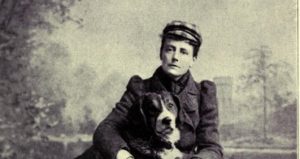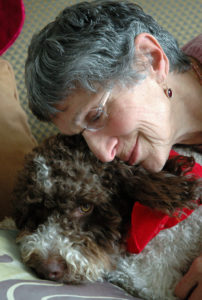
Wonderful World of Opera Dogs: Historic Composer Ethel Smyth Preference for Dogs Before People?
By Diana BurgwynOperaWire is proud to present “The Wonderful World of Opera Dogs,” a series by Diana Burgwyn, which will focus on the relationship between opera’s most iconic stars and their beloved canines. The creation of this series and all research necessary for each individual piece were conducted solely by Diana. To learn more about the origins of the project, click here.
When, in 2016, the opera “L’amour de loin” by the Finnish composer Kaija Saariaho had its highly successful premiere at the Metropolitan Opera, this was only the second time in Met history that an opera by a woman had been performed there. People began to wonder who had broken that glass curtain 113 years before.
Her name was Ethel Smyth, and she was a composer when women weren’t supposed to tackle that “manly” art. Most critics (male, of course) in the United States who were at the Met when her opera “Der Wald (The Forest)” had its two performances at the Met in 1903, went out of their way to belittle it, referring, for instance, to its “acrid” harmonies and “creakingly unmelodic phrases.” Some took the opportunity to remind their readers that women had no business being composers.
Smyth’s life was difficult in other ways. She was a suffragette, arrested and jailed for throwing a rock through the window of an important anti-suffrage politician who also a known pedophile. She was openly gay and fell in love with a married woman who was the mother of five children; later she was rebuffed as a romantic partner by the poet Virginia Woolf. Her “male” pursuits, such as golf, tennis, hunting, and smoking cigars invited gossip. Even her attire was of-off-putting–bowties or neckties, stiff white shirts, long, heavy skirts.
This less-than-traditional life, along with a sometimes brusque and feisty manner, made Ethel Smyth a misfit in British Victorian society. Over the years she became more distrustful of people and began to depend more on the love and loyalty of her dogs. Indeed, she wrote frequently about them, revealing her most open and tender feelings. This was an Ethel Smyth that most people never knew.
Marco
Her first dog, Marco, entered the scene in 1887 when a stray dog was found on a street in Vienna. In her memoirs, Smyth describes Marco as “a huge, sprawling yellow-and-white puppy of the long-haired kind generally seen dragging washer-women’s carts.” He was, she writes, “half St. Bernard and the rest what you please.” For Marco’s time on earth of 12 years, he was the joy of her life (and, she reports, the terror of her friends) during a period of intense work, including the composition of “Der Wald.”
The faithful Marco patiently spent hours with his mistress during her long days of composing, often lying with his head on the pedals of the piano or playing with his favorite toy, a little netted blue bag with long strings, which, she admits, eventually became a “repulsive” object. But whatever its olfactory or visual unpleasantness, the bag traveled with him and his mistress everywhere, wrapped in the Weekly Times.
Marco’s moment of fame–or, rather, infamy–occurred when Smyth was invited to attend a rehearsal that Johannes Brahms was holding of his F minor piano quintet. She left Marco in the street (one would assume, tethered). He must have heard what was going on in Brahms’ residence because while Smyth was seated at the piano turning pages for the composer, he burst into the house, dashed up two flights of stairs, and made his way to the room where Brahms and four local artists were rehearsing his F minor piano quintet. Overturning the cellist’s desk, Marco then dove under the piano and pushed his way between Smyth and the composer. Brahms, who could be gruff and even rude, to Smyth’s relief, “rose to the occasion” and “laughed till he got purple in the face.”
Smyth’s devotion to Marco was tested on one miserable trip when Smyth, who was ill with a raging fever, decided to leave Munich for her home in England. The journey was harrowing, and the only accommodation for dogs on the train was a square tunnel under the luggage van. Smyth wrote that she would never forget the “anguish of shoving that huge frightened dog into the horrible place and seeing the door locked on his poor white nose.” Despite her own miserable state of health, she “staggered through the snow and storm to the torture chamber” to reassure him through the ventilation holes, bribing the guard to bring him water and let her feed him.
Marco’s disposition sadly grew “nerve-rasped and ferocious” as he approached old age, and even his devoted mistress realized that he had become dangerous. When Marco was 12-years-old, she sadly sent him to what she hoped was a better world.
The Pans
Bereft of canines, Smyth turned to an acquaintance who gave her an Old English Sheepdog puppy. After experiencing one dog of this breed, no other would suit her. Their gentle, agreeable nature, meshed with physical strength and imposing height and weight made for an ideal companion. Over the years Smyth had five Old English Sheepdogs, naming all of them Pan because they seemed to suggest primitive ages when nymphs, fauns, and satyrs were “associated on equal terms with human beings.”
Among them, Pan IV was her favorite, and, in her memoirs, Smyth admits loving him more than all her dogs put together. He was a huge-boned animal with an abiding desire to please his mistress and an almost human understanding. The adults in Smyth’s circle learned to address him in a conversational voice, asking him, for instance, to see if the butcher was coming or to warning him not to stand so close to the fire. Friendly to all, Pan developed a great affection for one of Smyth’s friends, climbing up on the armchair where she was sitting and settling his heavy body on her lap, practically flattening it. When one less agreeable woman accused him unjustly of having eaten one of her chickens, he responded accordingly: every time she visited he would leave his spot under Smyth’s writing desk and move to the corner of the room where he would play “Dead Sheepdog.”
Smyth described Pan as “yearly growing more beautiful, his coat of a rich color and fabric, his head noble, his eyes big, melting, steady, loving.” He was “temperate as a saint,” lived each day to the fullest, and was never ill. She claimed that he had more of the traits she sought in humans than humans did.
“For seven years,” wrote Smyth, “we walked down the calendar together, step by step.”
Given Pan’s “bounding health,” her tender care, and the longevity of the breed, she expected him to outlive her. But that was not to be. During the winter of his seventh year—at a time when Smyth herself was elderly and losing her hearing, the most important crucial faculty of a composer’s life – Pan ceased responding to food (his passion had been white bread), lost weight, and grew weak, his rich coat fading and his strong neck shrinking to the size of a fox terrier. A famous veterinarian could not diagnose Pan’s illness. Despite his dwindling strength, Pan struggled almost to the end to be wherever Smyth was, managing to climb onto her armchair and squeeze up beside her.
After fighting for Pan’s life for over two months, Smyth realized that existing in his weakened state had become a burden to her beloved dog. One night, after he went missing, she finally found him in the dark of her garden, where he lay spent, on wet grass. Her decision was made. The veterinarian came the next day and Pan followed him to a spot he loved in the garden, lying down as Smyth instructed. Stroking his head, she told him “the old, old news that he was a beautiful dog. Indeed, his head had never lost the noble outline nor his face the matchless sweetness and dignity of expression.” And then he was put gently to sleep.
So great was Smyth’s grief over the loss of Pan that she decided to write about him in her autobiography, “in the hope of thereby drawing a few sharp thorns out of my heart and partly to join hands with those traveling the same road, and make them feel they were not alone in their sorrow.”
Smyth was addressing many of her compatriots in writing so passionately in her memoirs about her dogs. Victorian England, in the view of some scholars, was the place and time when the family dog as we know it today was “invented.” In well-to-do families, the home became an oasis of domestic bliss, and dogs, no longer relegated to back yards or kennels, lived in well-maintained residences, lying in the sun and dozing by the fireside. Owners mourned the death of their dogs, just as Smyth did, time after time.
Ethel Smyth’s career as a composer spanned more than a half-century. She wrote a total of six operas (including the librettos), as well as orchestral works, concertos, chamber music, sonatas and vocal music. Tchaikovsky was one of her admirers, and George Bernard Shaw claimed that Smyth’s music “cured me for ever [sic] of the delusion that women could not do man’s work in all things.” Over the year her fame grew, and her support of other women composers helped bring their work before the public.
On her 75th birthday, Smyth was celebrated in a festival, the final event of which was held at Royal Albert Hall in the presence of Queen Mary, who named her a Dame of the British Empire. By then the composer was completely deaf, unable to hear her own music being performed or the great enthusiasm of the audience.
But Ethel Smyth was not one to give up on life, and her last years were devoted to writing—10 books in all. One of them: “Inordinate (?) Affection: A Story for Dog Lovers,” written in 1936, was devoted to stories, photographs, and portraits of her six dogs, from Marco on.
In that book, she wrote that she had learned early on that the best way to recover from the death of a beloved dog was to obtain another one—as quickly as possible. So, after Pan IV’s death, she took on the care of her last dog, which had been a gift from several young nieces and nephews. A “ravishingly pretty” seven-and-one-half week-old Sheepdog puppy, he was coal black with white chest, face and paws, and with large bones that foretold an impressively large adulthood. As of that writing, the mischievous Pan V was learning some manners but was still capable of theft: specifically, removing Smyth’s false teeth from the cupboard and disappearing with them. She found them the next day, gleaming in the sun unharmed, next to the trunk of a birch tree.
Categories
Special Features


